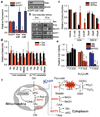Glutamine supports pancreatic cancer growth through a KRAS-regulated metabolic pathway
- PMID: 23535601
- PMCID: PMC3656466
- DOI: 10.1038/nature12040
Glutamine supports pancreatic cancer growth through a KRAS-regulated metabolic pathway
Erratum in
- Nature. 2013 Jul 25;499(7459):504
Abstract
Cancer cells have metabolic dependencies that distinguish them from their normal counterparts. Among these dependencies is an increased use of the amino acid glutamine to fuel anabolic processes. Indeed, the spectrum of glutamine-dependent tumours and the mechanisms whereby glutamine supports cancer metabolism remain areas of active investigation. Here we report the identification of a non-canonical pathway of glutamine use in human pancreatic ductal adenocarcinoma (PDAC) cells that is required for tumour growth. Whereas most cells use glutamate dehydrogenase (GLUD1) to convert glutamine-derived glutamate into α-ketoglutarate in the mitochondria to fuel the tricarboxylic acid cycle, PDAC relies on a distinct pathway in which glutamine-derived aspartate is transported into the cytoplasm where it can be converted into oxaloacetate by aspartate transaminase (GOT1). Subsequently, this oxaloacetate is converted into malate and then pyruvate, ostensibly increasing the NADPH/NADP(+) ratio which can potentially maintain the cellular redox state. Importantly, PDAC cells are strongly dependent on this series of reactions, as glutamine deprivation or genetic inhibition of any enzyme in this pathway leads to an increase in reactive oxygen species and a reduction in reduced glutathione. Moreover, knockdown of any component enzyme in this series of reactions also results in a pronounced suppression of PDAC growth in vitro and in vivo. Furthermore, we establish that the reprogramming of glutamine metabolism is mediated by oncogenic KRAS, the signature genetic alteration in PDAC, through the transcriptional upregulation and repression of key metabolic enzymes in this pathway. The essentiality of this pathway in PDAC and the fact that it is dispensable in normal cells may provide novel therapeutic approaches to treat these refractory tumours.
Figures




Comment in
-
Novel pathway identified for glutamine metabolism in PDAC.Nat Rev Gastroenterol Hepatol. 2013 May;10(5):260. doi: 10.1038/nrgastro.2013.57. Epub 2013 Apr 2. Nat Rev Gastroenterol Hepatol. 2013. PMID: 23545520 No abstract available.
-
Metabolism: Glutamine connections.Nat Rev Cancer. 2013 May;13(5):293. doi: 10.1038/nrc3515. Epub 2013 Apr 12. Nat Rev Cancer. 2013. PMID: 23584335 No abstract available.
-
Cancer metabolism in breadth and depth.Nat Biotechnol. 2013 Jun;31(6):505-7. doi: 10.1038/nbt.2611. Nat Biotechnol. 2013. PMID: 23752435 No abstract available.
References
-
- Hidalgo M. Pancreatic cancer. N Engl J Med. 2010;362:1605–1617. - PubMed
Publication types
MeSH terms
Substances
Grants and funding
LinkOut - more resources
Full Text Sources
Other Literature Sources
Medical
Miscellaneous

